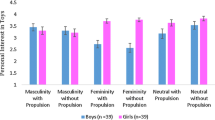Abstract
The purpose of this study was to determine whether, in four commonly observed childhood behaviors, the gross impression conveyed by “feminine” boys is distinctive from that of conventional boys, and in the direction of conventional girls. Three samples of children age 4–10 years were included in the study: boys with atypical sexual identity (N=12); age-matched conventionally sex-typed boys (N=8); and age-matched girls (N=7). The children were identically costumed to conceal gender and were videotaped while throwing a ball, walking, running, and telling a story. Videotaped segments of behaviors were randomly presented to four raters who judged the sex of the child on a five point scale which ranged from very likely male to very likely female. The analyses indicate that the sample to which the child belonged was the most important factor in explaining the rating the child received. The “feminine” boys occupied an intermediate position, one that was neither distinctly “feminine” nor distinctly “masculine.”
Similar content being viewed by others
References
Bates, J., Bentler, P., & Thompson, S. Gender deviant boys compared with normal and clinical control boys. Journal of Abnormal Child Psychology, 1979, 7, 243–259.
DSM-III. Diagnostic and statistical manual of mental disorders, III. Washington, D.C.: American Psychiatric Association, 1980.
Green, R. Sexual identity conflict in children and adults. New York: Basic Books and Viking/Penguin; London: Gerald Duckworth, 1974.
Green, R. One-hundred ten feminine and masculine boys: Behavioral contrasts and demographic similarities. Archives of Sexual Behavior, 1976, 5, 425–446.
Winer, B. J. Principles in experimental design (2nd ed.). New York: McGraw-Hill, 1971.
Author information
Authors and Affiliations
Additional information
This study was supported by NIMH Grant MH 24–305, Foundations' Fund for Research in Psychiatry Grant G-69-471, and a Playboy Foundation grant, all to Richard Green, M.D.
The authors gratefully acknowledge Kapo Yuen and Leon Brown, who provided valuable assistance with data computation, and Victor Russek, who helped with videotape editing.
Rights and permissions
About this article
Cite this article
Green, R., Neuberg, D.S. & Finch, S.J. Sex-typed motor behaviors of “feminine” boys, conventionally masculine boys, and conventionally feminine girls. Sex Roles 9, 571–579 (1983). https://doi.org/10.1007/BF00290065
Issue Date:
DOI: https://doi.org/10.1007/BF00290065



